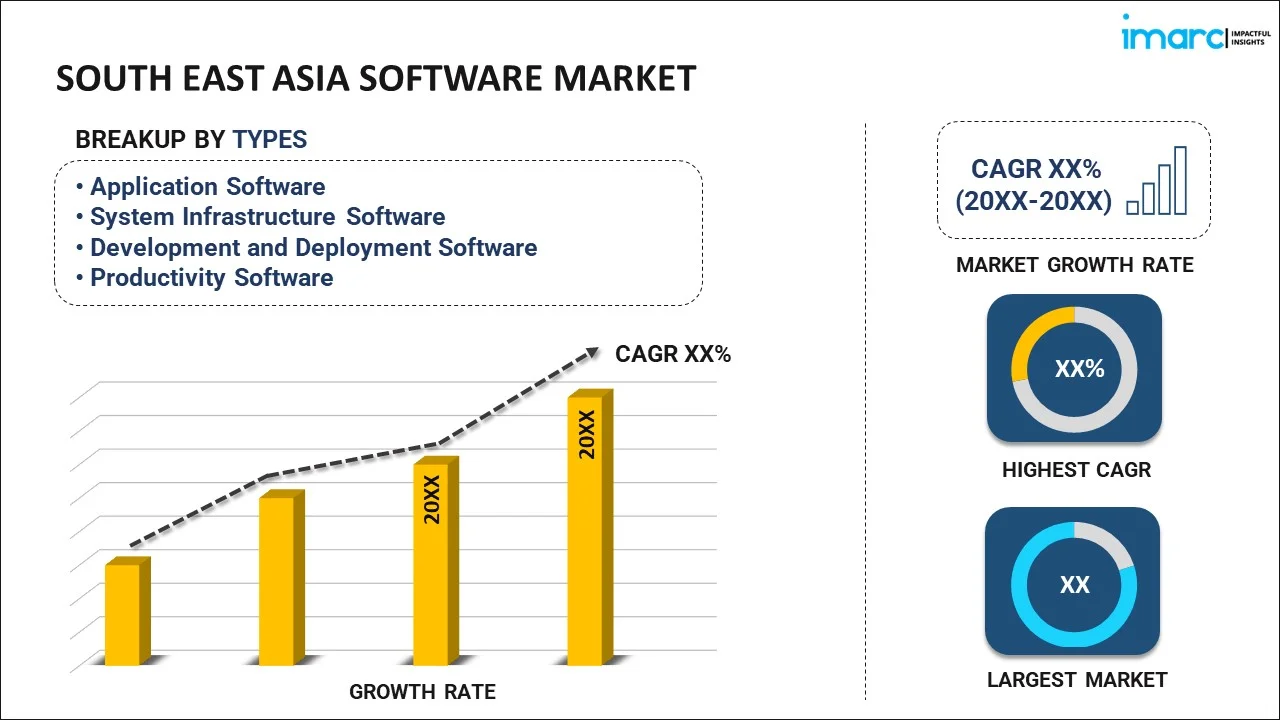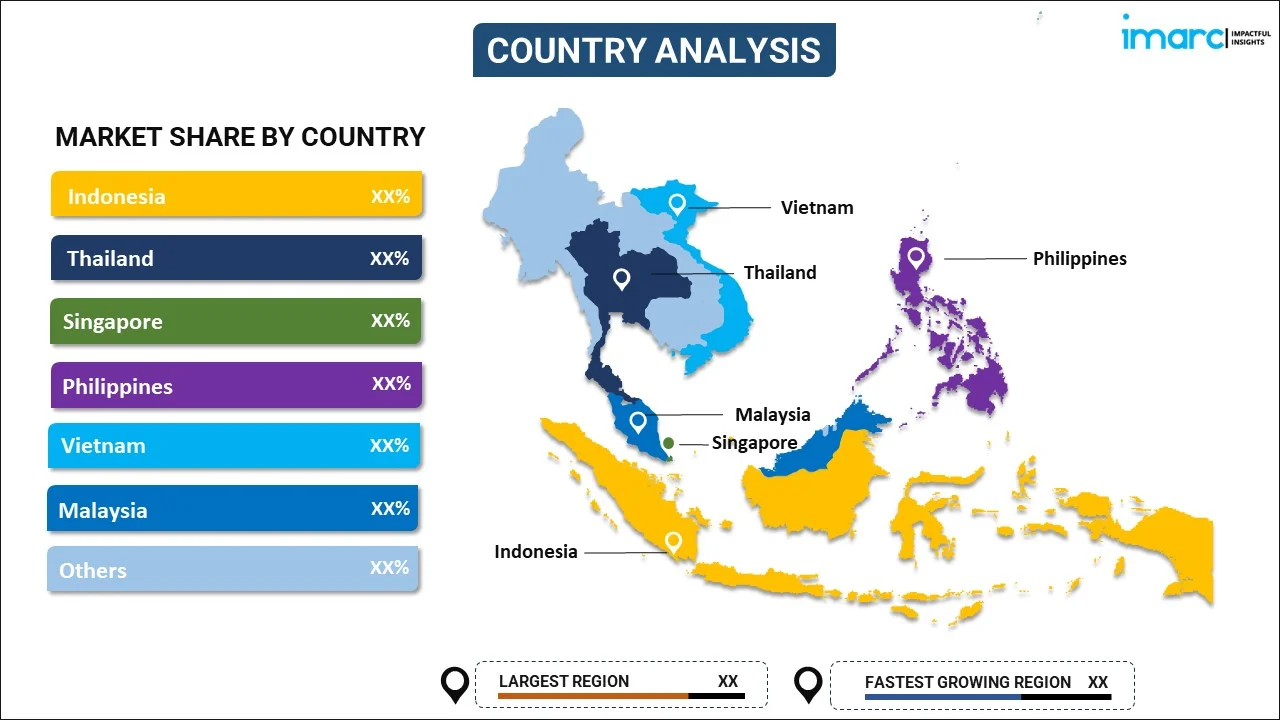
South East Asia Software Market Report by Type (Application Software, System Infrastructure Software, Development and Deployment Software, Productivity Software), Deployment Mode (On-premises, Cloud-based), Enterprise Size (Small and Medium-sized Enterprises, Large Enterprises), Industry Vertical (IT and Telecom, BFSI, Retail, Government/Public Sector, Energy and Utilities, Healthcare, and Others), and Country 2025-2033
Market Overview:
South East Asia software market size reached USD 10.9 Million in 2024. Looking forward, IMARC Group expects the market to reach USD 44.9 Million by 2033, exhibiting a growth rate (CAGR) of 15.7% during 2025-2033. The rapid advancements in technology, such as artificial intelligence, machine learning, blockchain, and cloud computing, which increase the demand for new and innovative software solutions, is driving the market.
|
Report Attribute
|
Key Statistics
|
|---|---|
|
Base Year
|
2024
|
|
Forecast Years
|
2025-2033
|
|
Historical Years
|
2019-2024
|
|
Market Size in 2024
|
USD 10.9 Million |
|
Market Forecast in 2033
|
USD 44.9 Million |
| Market Growth Rate 2025-2033 | 15.7% |
Software refers to a set of instructions and data that enable a computer or electronic device to perform specific tasks or functions. It encompasses a wide range of programs, applications, and operating systems designed to facilitate user interactions and manage hardware resources. Software can be categorized into two main types: system software, which includes operating systems and utilities that control and support the hardware, and application software, which consists of programs tailored to perform specific user-oriented tasks. Software development involves the creation, testing, and maintenance of these programs, often carried out by skilled professionals known as software developers or engineers. The field is dynamic, with constant updates and innovations driven by technological advancements. Software plays a crucial role in modern society, powering everything from personal devices and business applications to complex systems in sectors such as healthcare, finance, and entertainment.
South East Asia Software Market Trends:
The software market in South East Asia is continually evolving, driven by a myriad of factors that collectively shape its trajectory. Firstly, the relentless pace of technological innovation serves as a primary catalyst, propelling the software market forward. As emerging technologies such as artificial intelligence, blockchain, and the Internet of Things gain prominence, the demand for sophisticated software solutions escalates in tandem. Moreover, the regional shift towards digital transformation acts as a powerful driver, compelling businesses across diverse sectors to invest in software that enhances efficiency, connectivity, and overall operational agility. Furthermore, the increasing prevalence of remote work has fueled a surge in demand for collaborative and cloud-based software solutions. This paradigm shift in work dynamics underscores the importance of software that facilitates seamless communication and collaboration irrespective of geographical boundaries. Additionally, the growing awareness and emphasis on cybersecurity, which increases investments in advanced software to protect against evolving threats and vulnerabilities, is expected to drive the market in South East Asia during the forecast period.
South East Asia Software Market Segmentation:
IMARC Group provides an analysis of the key trends in each segment of the market, along with forecasts at the regional and country levels for 2025-2033. Our report has categorized the market based on type, deployment mode, enterprise size, and industry vertical.
Type Insights:

- Application Software
- Enterprise Resource Planning (ERP)
- Customer Relationship Management (CRM)
- Supply Chain Management (SCM)
- Enterprise Collaboration Software
- Enterprise Content Management (ECM) Software
- Education Software
- Others
- System Infrastructure Software
- Network Management Systems (NMS)
- Storage Software
- Security Software
- Development and Deployment Software
- Enterprise Data Management (EDM)
- Business Analytics and Reporting Tools
- Application Servers
- Integration and Orchestration Middleware
- Data Quality Tools
- Productivity Software
- Office Software
- Creative Software
- Others
The report has provided a detailed breakup and analysis of the market based on the type. This includes application software (enterprise resource planning (ERP), customer relationship management (CRM), supply chain management (SCM), enterprise collaboration software, enterprise content management (ECM) software, education software, and others), system infrastructure software (network management systems (NMS), storage software, and security software), development and deployment software (enterprise data management (EDM), business analytics and reporting tools, application servers, integration and orchestration middleware, and data quality tools), and productivity software (office software, creative software, and others).
Deployment Mode Insights:
- On-premises
- Cloud-based
A detailed breakup and analysis of the market based on the deployment mode have also been provided in the report. This includes on-premises and cloud-based.
Enterprise Size Insights:
- Small and Medium-sized Enterprises
- Large Enterprises
The report has provided a detailed breakup and analysis of the market based on the enterprise size. This includes small and medium-sized enterprises and large enterprises.
Industry Vertical Insights:
- IT and Telecom
- BFSI
- Retail
- Government/Public Sector
- Energy and Utilities
- Healthcare
- Others
A detailed breakup and analysis of the market based on the industry vertical have also been provided in the report. This includes IT and telecom, BFSI, retail, government/public sector, energy and utilities, healthcare, and others.
Country Insights:

- Indonesia
- Thailand
- Singapore
- Philippines
- Vietnam
- Malaysia
- Others
The report has also provided a comprehensive analysis of all the major regional markets, which include Indonesia, Thailand, Singapore, Philippines, Vietnam, Malaysia, and Others.
Competitive Landscape:
The market research report has also provided a comprehensive analysis of the competitive landscape. Competitive analysis such as market structure, key player positioning, top winning strategies, competitive dashboard, and company evaluation quadrant has been covered in the report. Also, detailed profiles of all major companies have been provided.
South East Asia Software Market Report Coverage:
| Report Features | Details |
|---|---|
| Base Year of the Analysis | 2024 |
| Historical Period | 2019-2024 |
| Forecast Period | 2025-2033 |
| Units | Million USD |
| Scope of the Report | Exploration of Historical and Forecast Trends, Industry Catalysts and Challenges, Segment-Wise Historical and Predictive Market Assessment:
|
| Types Covered |
|
| Deployment Modes Covered | On-premises, Cloud-based |
| Enterprise Sizes Covered | Small and Medium-sized Enterprises, Large Enterprises |
| Industry Verticals Covered | IT and Telecom, BFSI, Retail, Government/Public Sector, Energy and Utilities, Healthcare, Others |
| Countries Covered | Indonesia, Thailand, Singapore, Philippines, Vietnam, Malaysia, Others |
| Customization Scope | 10% Free Customization |
| Post-Sale Analyst Support | 10-12 Weeks |
| Delivery Format | PDF and Excel through Email (We can also provide the editable version of the report in PPT/Word format on special request) |
Key Questions Answered in This Report:
- How has the South East Asia software market performed so far and how will it perform in the coming years?
- What has been the impact of COVID-19 on the South East Asia software market?
- What is the breakup of the South East Asia software market on the basis of type?
- What is the breakup of the South East Asia software market on the basis of deployment mode?
- What is the breakup of the South East Asia software market on the basis of enterprise size?
- What is the breakup of the South East Asia software market on the basis of industry vertical?
- What are the various stages in the value chain of the South East Asia software market?
- What are the key driving factors and challenges in the South East Asia software?
- What is the structure of the South East Asia software market and who are the key players?
- What is the degree of competition in the South East Asia software market?
Key Benefits for Stakeholders:
- IMARC’s industry report offers a comprehensive quantitative analysis of various market segments, historical and current market trends, market forecasts, and dynamics of the South East Asia software market from 2019-2033.
- The research report provides the latest information on the market drivers, challenges, and opportunities in the South East Asia software market.
- Porter's five forces analysis assist stakeholders in assessing the impact of new entrants, competitive rivalry, supplier power, buyer power, and the threat of substitution. It helps stakeholders to analyze the level of competition within the South East Asia software industry and its attractiveness.
- Competitive landscape allows stakeholders to understand their competitive environment and provides an insight into the current positions of key players in the market.
Need more help?
- Speak to our experienced analysts for insights on the current market scenarios.
- Include additional segments and countries to customize the report as per your requirement.
- Gain an unparalleled competitive advantage in your domain by understanding how to utilize the report and positively impacting your operations and revenue.
- For further assistance, please connect with our analysts.
 Inquire Before Buying
Inquire Before Buying
 Speak to an Analyst
Speak to an Analyst
 Request Brochure
Request Brochure
 Request Customization
Request Customization




.webp)




.webp)












